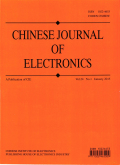- 钛学术文献服务平台 \
- 学术期刊 \
- 工业技术期刊 \
- 无线电电子学与电信技术期刊 \
- 中国电子杂志(英文版)期刊 \
A Novel Multiple Access Protocol for Mobile Ad Hoc Network with Smart Antennas
A Novel Multiple Access Protocol for Mobile Ad Hoc Network with Smart Antennas
基本信息来源于合作网站,原文需代理用户跳转至来源网站获取
摘要:
The approach to employ smart antennas in Mobile ad hoc network (MANET) nodes is presented. An adaptive beamforming-Carrier-Sense multiple access/collison avoidance) (ABF-CSMA/CA) protocol is proposed. In the ABF-CSMA/CA, Request-to-Send/Clear-to-Send (RTS/CTS) dialogue is used to distribute channel reservation information. Training sequences are transmitted just before RTS and CTS packets, so the Temporal reference beamforming (TRB) can be performed by the source node and the destination node.An improved virtual carrier-sense mechanism is also proposed to enhance Collision avoidance (CA) and obtain efficient Space division multiple access (SDMA). In this scheme, every node has two kinds of Network allocation vector (NAV): an oNAV maintains the interval of ongoing transmission of neighbors whose smart antennas operate in omnidirectional mode, and multiple bNAVs maintain those intervals of neighbors whose smart antennas operate in beamforming mode. Theoretical analysis of channel utilization of the proposed protocol is presented. Results show that ABF-CSMA/CA protocol combining with smart antennas can provide higher channel utilization.

推荐文章
移动Ad hoc网络路由协议的研究
移动自组网络
按需距离矢量路由
邻域按需距离矢量路由
LAMR:移动Ad hoc网络位置匿名的多路径路由协议
路由协议
位置
匿名性
多路径
无线特定网络--Ad Hoc网络
Ad Hoc网络 网络结构 路由协议 AODV DSR
无线Ad Hoc网络功率控制研究
无线Ad Hoc网络
功率控制
节能
内容分析
关键词云
关键词热度
相关文献总数
(/次)
(/年)
引文网络
引文网络
二级参考文献 (0)
共引文献 (0)
参考文献 (0)
节点文献
引证文献 (0)
同被引文献 (0)
二级引证文献 (0)
2004(0)
- 参考文献(0)
- 二级参考文献(0)
- 引证文献(0)
- 二级引证文献(0)
研究主题发展历程
节点文献
移动AdHoc网络
智能天线
多路存取协议
TRB
CTS
研究起点
研究来源
研究分支
研究去脉
引文网络交叉学科
相关学者/机构
期刊影响力
中国电子杂志(英文版)
主办单位:
出版周期:
季刊
ISSN:
1022-4653
CN:
N
开本:
出版地:
北京165信箱
邮发代号:
创刊时间:
语种:
eng
出版文献量(篇)
1919
总下载数(次)
1
总被引数(次)
318
期刊文献
相关文献
推荐文献
- 期刊分类
- 期刊(年)
- 期刊(期)
- 期刊推荐
一般工业技术
交通运输
军事科技
冶金工业
动力工程
化学工业
原子能技术
大学学报
建筑科学
无线电电子学与电信技术
机械与仪表工业
水利工程
环境科学与安全科学
电工技术
石油与天然气工业
矿业工程
自动化技术与计算机技术
航空航天
轻工业与手工业
金属学与金属工艺
中国电子杂志(英文版)2019
中国电子杂志(英文版)2015
中国电子杂志(英文版)2013
中国电子杂志(英文版)2012
中国电子杂志(英文版)2011
中国电子杂志(英文版)2010
中国电子杂志(英文版)2009
中国电子杂志(英文版)2008
中国电子杂志(英文版)2007
中国电子杂志(英文版)2006
中国电子杂志(英文版)2005
中国电子杂志(英文版)2004
中国电子杂志(英文版)2003
中国电子杂志(英文版)2001

 免费查重
免费查重










